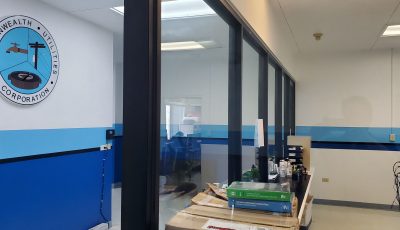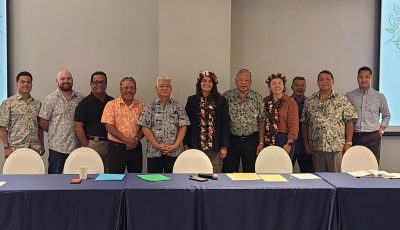MARIANAS MATTERS
Environmental promises of EPA and DOI—can they deliver?
The Pacific Islands Environmental Conference recently concluded its 28th session held in June in American Samoa. In attendance were federal agencies led by the Environmental Protection Agency (EPA), private sector interests, non-profit groups, and local island government officials from the U.S. flag areas. The conference was co-sponsored by the CNMI Bureau of Environmental and Quality Control, along with the Guam EPA and the host American Samoa EPA.
What caught my attention more than anything else, much to the delight of the predominately American Samoa audience was the bold vision and proclamation by Jared Blumenthal, Region 9 Administrator of EPA, whose responsibilities encompasses Hawaii and the U.S. Pacific Islands, that the Manua Islands would be targeted as “the first islands in the world to be 100-percent powered by renewable energy.” To this end, he pledged to introduce electric vehicles to the territory, including installing a solar battery storage on Manua. He assured American Samoa that he will work with them to increase recycling, hopefully decreasing their dependence on the need for a landfill.
Blumenthal displayed a keen sensitivity to the Pacific Islands by acknowledging the special relationship that Island people have to the ocean. “For generations, Pacific Islanders have learned how to work together to cross the vast ocean. They did this by being wise navigators and by paddling in unison,” said Blumenthal, an obvious nod to our rich cultural heritage of exploration and our penchant of always looking for ways to work together as Pacific Islanders.
He recognized the long-standing concerns that Pacific Island inhabitants harbor of the dangerous and unhealthy materials and substances that are being dumped into the ocean all too easily. He was quick to praise the compliance efforts by Pacific Island governments to implement provisions of the Clean Water Act aimed at curbing pollution and erosion and to ensure that coastal waters are protected in the face of climate change. Blumenthal pledged to have the EPA do more in partnering with the Department of the Interior’s Assistant Secretary for Insular Affairs Esther Kia’aina’s office and NOAA to assist the islands with climate adaptation tools for their coastal reefs and water utilities. He also offered kind words for Island efforts in utilizing more solar energy in their respective jurisdictions.
Kia’aina also convened a week before Blumenthal’s conference in American Samoa her Climate Change Stakeholder Meeting in Guam. In addition to the CNMI, Guam and American Samoa, participating officials included those from the Federated States of Micronesia, the Republic of the Marshall Islands, the Republic of Palau, the U.S. Virgin Islands, NGO representatives, and academicians. Besides offering and discussing myriad ways to handle and manage climate change, the conference at Kia’aina’s insistence was eager to gather information to take back to Washington to position her office to better identify and advocate for funding sources to assist with the implementation of action plans and ideas that arose from the Stakeholder Meeting. She pledged to improve the islands’ “capacities for climate change adaptation and resiliency strategies.”
There is a tendency at times and it is prevalent in the islands or in underserved or rural communities throughout the nation to look askance or take a “ wait-and-see approach” when federal government officials make promises that appear to be difficult, challenging, or grandiose. How many times have we reacted by saying, “the rhetoric was beautiful but can they really deliver? Our doubts and questions are exacerbated when we don’t really know who these federal officials are and have no history of dealing with them.
In the case of Assistant Secretary Kia’aina, we are very familiar with her background. The Guam-born native not only has roots deep in this area, but has a track record of accomplishments in Hawaii. Her family resides in a predominantly Native Hawaiian area on Oahu, so in addition to her familiarity with Micronesian issues, she is very well versed in Hawaiian and Polynesian subjects as well. Having worked as a key assistant to former Hawaii U.S. Senator Dan Akaka and U.S. Congressman Ed Case, she developed an outstanding reputation for being an astute administrator and amassed a wealth of knowledge and contacts in the nation’s Capitol. Esther was extremely resourceful and helpful to me when I had to lobby Washington to keep Pearl Harbor Naval Shipyard from closing when I was Honolulu mayor. Lastly, she has always had a strong environmental background. Her last government post in Hawaii before she headed off to Washington again was serving as the deputy director of the all-important State Department of Land and Natural Resources. Most importantly, in all my personal and professional dealings with Kia’aina, I have found her to be hard working, trustworthy, and a person of her word. She is the “real deal.”
And what about the San Francisco-based Blumenthal? Unlike Kia’aina, unless you are a government official working on issues dealing with the EPA, it’s safe to say you haven’t heard of him. My position as mayor of Honolulu compelled me to get to know him. Why? Because Honolulu was under a consent degree and very much on the radar screen for its failure to go to secondary treatment of its wastewater. We were being sued by a who’s who of environmental stakeholders led by the EPA that had a contentious lawsuit against the nation’s 13th largest city. Believe you me, it was a challenge I wished I hadn’t inherited under my watch. However, my DNA is such that I felt Honolulu could no longer afford to continue to kick this problem down the road and we needed to reach a reasonable settlement with EPA, one of the strictest and toughest government agencies.
Fortunately for me, Blumenthal, who was new to his job, shared my opinion and was eager to reach a fair and doable settlement, something his predecessors like mine could not do. What ensued was a series of shuttle diplomacies between Honolulu and San Francisco where we met eyeball to eyeball across the table from each other (we sat most of the time since I stand 6’7” and Blumenthal is about a foot shorter) We developed a relationship based on trust, respect, and in the end admiration, especially when we accomplished which many deemed impossible—an end to the decades long costly lawsuit against our city and county. My staff did yeoman work in helping me put a plan in place to commit and transform Honolulu into the 21st century with respect to its sewage and wastewater treatment. Through it all I found Blumenthal to be diligent, honest, and a person of his word. He is also the “real deal. “
The point of all of this is to say to all island government officials and agencies, who have to deal with the EPA and DOI, take advantage of these two public servants while they are serving in their capacities. No one is perfect and some issues will be more challenging than others so you need to do your part and be patient and creative with them in the process. Bottom line is given the importance of climate change and the accompanying plethora of environmental issues—take Jared Blumenthal and Esther Kia’aina at their word and work with them to create a better quality of life for generations to come. (Mufi Hannemann)



























